 |
| See how I answered the quiz about spiritual death. |
In a previous post (“Temporal Separation versus Spiritual Separation“), I gave three examples of various authors or speakers describing spiritual death. For each, I gave a quote, my rationale for rating it, a chart that illustrates the quote’s conception of spiritual death, and one of three ratings: Accurate and Thorough, Accurate but Simplified, and Inaccurate or Unclear.
In the post after that (“Spiritual Death Quiz“), I gave readers eleven more quotes to try rating on their own. In this post, I will repost the quotes with the text colored so it corresponds to the chart, a brief rationale, and a final rating. Color is used in the following ways:
Quotes
- Red text is interpreted as referring to the temporal separation.
- Blue text is interpreted as referring to the spiritual separation.
- Grey text is for references with unclear meaning.
Charts
- Green dots are clear referencesto that element.
- Yellow dots are possible referencesto that element.
- Grey dots are unclear references to that element.
Lines and Ratings
- Two straight lines: Accurate and Thorough
- One straight line: Accurate but Simplified
- Diagonal or zig-zag line: Inaccurate or Unclear
Before reading this post, I recommend taking the quiz on the previous post. (Just FYI, on the quiz, I sneakily included my answers right after each quote, in white-colored text that can only be seen if you highlight it. They were there the whole time and you didn’t even know it! Tee hee.)
My Ratings
1. Source: Bruce R. McConkie, “The Three Pillars of Eternity,†BYU devotional, 17 Feb. 1981, speeches.byu.edu.
The fall of Adam brought temporal and spiritual death into the world, and the atonement of Christ ransomed men from these two deaths. …
Spiritual death. This is death as pertaining to the things of the Spirit. It is death as pertaining to things of righteousness. It is to be cast out of the presence of the Lord. It is a way of life which is in opposition to that of the Father of us all. Because of the atonement, because the Lord Jesus bore our sins on conditions of repentance, we have power to gain eternal life, which is spiritual life, which is a life of righteousness, which is life in the presence of our God.
Although Elder McConkie mentions the Fall of Adam, he does not appear to be saying that it is the direct cause of an individual’s spiritual separation from God; thus, it seems accurate to me. Neither, however, does he seem to be bringing in the concept of temporal separation at all; thus it seems simplified.
Rating: Accurate but Simplified
2. Source: Aaronic Priesthood Manual 3 (1995), Lesson 7: “The Atonement Brings Victory over Death and Hell.”
Spiritual death (sometimes called hell) … is a separation or banishment from the presence of God. … We can all return to Heavenly Father’s presence, overcoming spiritual death. As all were cut off from the presence of God by Adam’s fall, all who repent of their sins will be restored to the presence of God through Christ’s atonement.
This is another example where the author may indeed have understood the distinction between the two types of separation, but his/her execution was very confusing, just speaking personally from memories as a youth trying to understand this doctrine.
Rating: Inaccurate or Unclear
3. Source: Robert J. Matthews, “Fall of Adam,” Encyclopedia of Mormonism (New York: Macmillan, 1992), p. 485.
The Fall brought two kinds of death upon Adam, Eve, and their posterity: the separation of the spirit and the physical body, which the scriptures call the “temporal death”; and being shut out of God’s presence, which is called spiritual death. Jesus Christ redeems all mankind unconditionally from the two deaths brought by the Fall of Adam, raises all mankind from the grave, and restores them to God’s presence for a judgment.
The author limits himself to discussion of only one type of spiritual death (the temporal separation), so I considered it simplified. Interestingly, this is one of the only simplified quotes I found where the author focuses on temporal separation; most quotes that only focus on one aspect focus on the spiritual separation.
Rating: Accurate but Simplified
4. Source: Mack C. Sterling, “The Way of Life and the Way of Death in the Book of Mormon,” Journal of Book of Mormon Studies (Provo, Utah: Maxwell Institute, 1997) v6 n2, pp. 152-204.
Spiritual death—the spiritual death of probation—consists of two components: physical separation from the presence of God caused by the fall of Adam and spiritual alienation from God caused by our individual sins. … Our spiritual alienation is overcome by becoming spiritually begotten of God and thereafter growing up in the spirit. Spiritual alienation diminishes proportionately as spiritual life matures in us. Physical separation from the presence of God, although transiently overcome at the judgment for all men, is overcome in a more meaningful and lasting way by those who persist in the way of life.
Brother Sterling does an effective job of distinguishing the two kinds of separation and describing their definitions, causes, resolutions, and conditions (for spiritual separation, he might be hinting at the conditions of repentance with phrases like choosing to “grow up in the spirit†and having “spiritual life mature in usâ€).
Rating: Accurate and Thorough
5. Source: Sue Bergin, “Life and Death, Spiritual,” Encyclopedia of Mormonism (New York: Macmillan, 1992), p. 832–33.
The scriptures speak of two spiritual deaths. The first has already come upon all humans as a result of the Fall, separating “all mankind … from the presence of the Lord.” … Spiritual death [means] that one is in “a state of spiritual alienation from God,” a death “as to things pertaining unto righteousness.” Because little children are not capable of sinning, the first spiritual death does not begin for an individual on the earth until the age of accountability. … Insofar as they do not harmonize behavior with an understanding of truth and goodness, they create a gulf between themselves and God-that is, spiritual death. … Christ’s Atonement … overcomes the first spiritual death by making it possible for all men and women to come into God’s presence to be judged.
This was probably the hardest one for me to rate. Part of it may be how she was using the term “second death”; I’m still not fully settled on whether that term is synonymous with “spiritual separation,” or whether it means “both separations a second time.” Regardless, it was still very difficult to analyze. I reread the entire article several times, but in the end, I chose Inaccurate or Unclear because I couldn’t tell how she was relating the various elements. Sister Bergin, if you’re out there and I’ve misunderstood you, please forgive me!
Notably, while several quotes with the same rating start on the left and curve to the right (see numbers 2 and 6), this is the only one I’ve found that starts on the right and curves to the left. In other words, most Inaccurate or Unclear quotes say, “It’s caused by Adam, but individuals have to do certain things to overcome it,” but this one seems to say, “It’s caused by individual sin, but you don’t have to do anything to overcome it (at least temporarily).”
Rating: Inaccurate or Unclear
6. Source: Gale(?), “The Plan of Salvation 2: The Purpose of Life on Earth,” MormonBeliefs.org, accessed 25 Feb. 2011.
Once banished from the garden, Adam and Eve became subject to two kinds of death—physical death, and spiritual death. … Spiritual death is the separation from God, who walked and talked with Adam and Eve in the garden. All of us are subject to these two deaths. … Christ’s atonement covered both forms of death, both physical and spiritual. … Spiritual death is banished, if we only avail ourselves of the Lord’s grace through the atonement of Christ.
This one is the classical formulation that Elder Lund warns against. Notice that the diagram is identical to the Aaronic Priesthood Manual quote (number 2).
Rating: Inaccurate or Unclear
7. Source: Richard M. Romney, “Spiritual Death,” Encyclopedia of Mormonism.
The first type of spiritual death is the actual separation from God that automatically comes upon all born into mortality as a consequence of the Fall of Adam. All mortals will be redeemed from this death, as well as from physical death, through Christ’s Atonement and resurrection, to be brought back into God’s presence to stand before him.
The second spiritual death … is the result of a lifetime of choices. … All people on earth over the age of accountability are to a certain extent spiritually dead, depending on their present state of repentance and their degree of sensitivity … to the Holy Ghost. … The only permanent spiritual death is that which individuals bring upon themselves by refusing to repent of their sins, having denied the Holy Spirit after having received it.
This is perhaps the most thorough quote I’ve found. It covers almost all the elements. By now, though, you might have noticed that virtually none of the quotes used so far covers the element of necessity. In other words, in our descriptions of spiritual death, we often fail to emphasize that one is necessary to become like God, and the other is absolutely unnecessary. Perhaps that is an area that we as Latter-day Saints can do better at being more explicit on. This common shortfall in our explanations is one reason I decided to write the series “The Path of Sin” and “The Path of Adam’s Fall.”
Rating: Accurate and Thorough
8. Source: Rachel Bruner, “How the Atonement of Christ Saves Us: Salvation from Physical and Spiritual Death through the Atonement,” About.com, accessed 25 Feb. 2011.
Sin … separates us from God—this is spiritual death. To be saved from spiritual death, called eternal life, can only be achieved through the Atonement of Christ and is conditional upon our obedience to the gospel of Jesus Christ. To receive eternal life we must: exercise faith in Christ, repent, be baptized, receive the Holy Ghost, and endure to the end (continue to obey God’s commandments).
This is a good, basic explanation of the spiritual aspect of spiritual death. Once again, just because it omits the temporal aspect of spiritual death doesn’t make it wrong.
Rating: Accurate but Simplified
9. Source: Dallin H. Oaks, “The Light and Life of the World,” Ensign, Nov. 1987, p. 63.
By yielding to temptation, Adam and Eve were “cut off from the presence of the Lord.” In the scriptures this separation is called spiritual death.
The atonement of our Savior overcame this spiritual death. The scriptures say, … “Therefore as by the offence of one, judgment came upon all men to condemnation; even so by the righteousness of one, the free gift came upon all men unto justification of life.†As a result of this atonement, “men will be punished for their own sins, and not for Adam’s transgression.”
Our Savior has redeemed us from the sin of Adam, but what about the effects of our own sins? Since “all have sinned,” we are all spiritually dead.
Again, our only hope for life is our Savior, who … “offereth himself a sacrifice for sin.†In order to lay claim upon our Savior’s life-giving triumph over the spiritual death we suffer because of our own sins, we must follow the conditions he has prescribed. As he has told us in modern revelation, “I, God, have suffered these things for all, that they might not suffer if they would repent.” … In the words of our Savior, … “Whosoever will hearken unto my words and repenteth and is baptized, the same shall be saved.â€
Elders Oaks uses more general language, and he doesn’t specify that the “free gift” of overcoming spiritual death consists of the Judgement. But it seems pretty clear he’s referring to two types of spiritual death—one caused by Adam’s Fall and overcome unconditionally, and another we bring upon ourselves which is overcome on conditions of repentance.
Rating: Accurate and Thorough
10. Source: “Atonement of Jesus Christ,” WhyMormonism.org, accessed 8 Mar. 2011.
Adam’s Fall cut off mankind from the presence of God. To bring mankind back into the presence of God required a Savior. Because fallen mankind was bound to sin and be unable to bring themselves back into God’s presence on their own, someone perfect would have to do what they could not do. …
Both physical and spiritual death (being cut off from God’s presence) came into the world as a result of the Fall of Adam. As our Savior, Jesus Christ saved our bodies from physical death and showed us the way to save our souls from spiritual death. Because Christ was resurrected, resurrection is a gift given to all mankind, whether good or evil. The Atonement of Christ saves us from spiritual death. Jesus Christ suffered for our sins to give us the power to repent from them and return to live with God.
This one was tricky because of the way the author mentions both Adam’s Fall and sin. I don’t see him distinguishing between two kinds of spiritual death (he uses the term as though it were one entity), so it can’t be rated thorough. He seems to say that spiritual death is caused by Adam’s Fall, but is made insuperable by sin, implying that you or I could overcome it on our own if we were sinless (there was a time when that was my tentative explanation, but I’m no longer inclined toward that idea because of 2 Ne. 9:8-9). In the end, I had to rate it Inaccurate or Unclear because I couldn’t be certain how he was connecting cause and conditions.
Rating: Inaccurate or Unclear
11. Source: “Jesus Christ,” MormonYouth.org, accessed 8 Mar. 2011.
Through his atonement, Christ saved us from both physical and spiritual death. Because of the Fall of Adam and Eve, each of us is mortal (physical death) and each of us is separated from God (spiritual death). Everyone, regardless of who they are or what they’ve done, will be resurrected and brought back before God for judgment, thus overcoming both physical and spiritual death. Whether we are worthy to remain in God’s presence and return to live with Him will depend upon the choices we made while in this life and how effectively we used the power of the atonement in our lives.
Like the quote from Brother Matthews, this is the only other one I’ve found that discusses only the temporal separation. Well, I guess in the last sentence, it also talks about sin and repentance, but it doesn’t specify that that is a type of spiritual death. For that reason, I called it simplified.
Notice also that in all these quotes, the grey text (“meaning is unclear”) was only ever used on the ambiguity of what exactly is meant by “separation from God.” In other words, the only time (that I noticed) that an element is mentioned without being further described is the definition element. That seems to be another area where we could stand to be a little more detailed, by explaining what we mean when we say “separated from God,” and that there are two ways to be separated.
Rating: Accurate but Simplified
Conclusion
I hope that this little survey of LDS writings has helped in a few ways. First, I hope it has given readers the chance to cement their understanding of the two kinds of spiritual death. Second, I hope it gives readers an accurate portrait of the current state of the general membership’s understanding of this doctrine. I hope that we all have the chance to improve just a little bit in conveying more clearly the profoundly meaningful teachings of the Restoration.
In my next post, I will explain four common misunderstandings that can potentially arise when people do not understand the distinction between the two types of spiritual death. Following that post, I will discuss how this relates to the two series I published last year, “The Path of Sin” and “The Path of Adam’s Fall.”
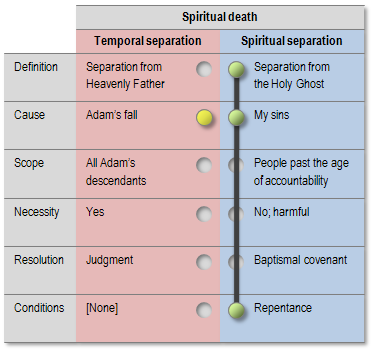
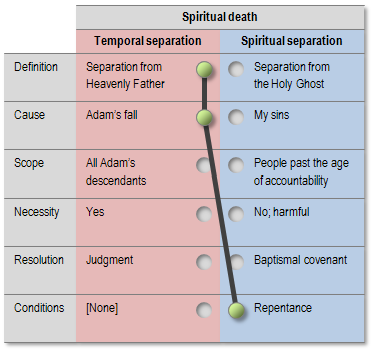
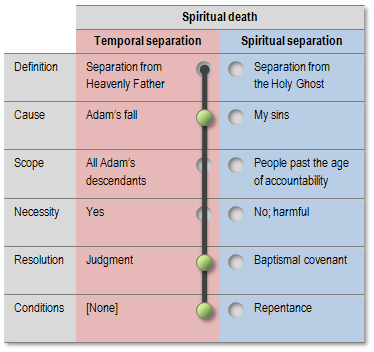
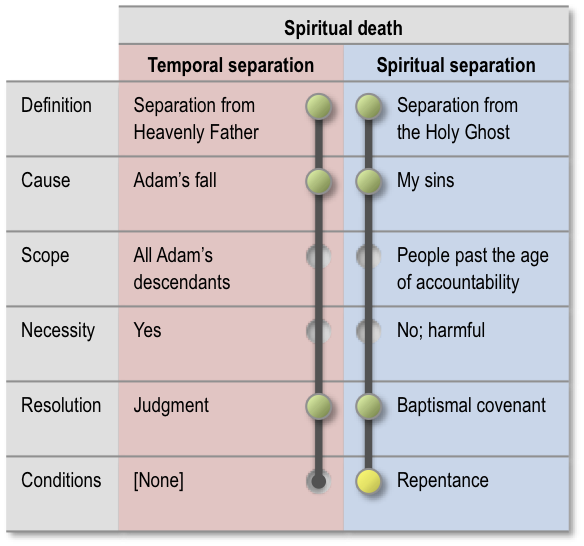
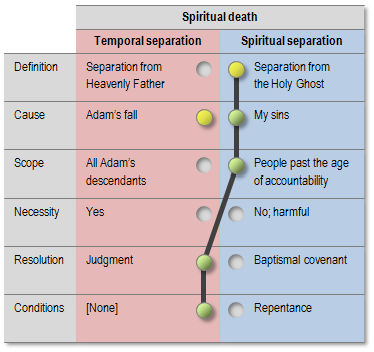
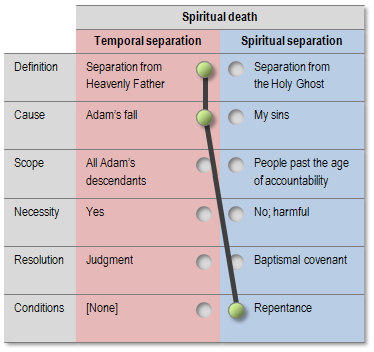

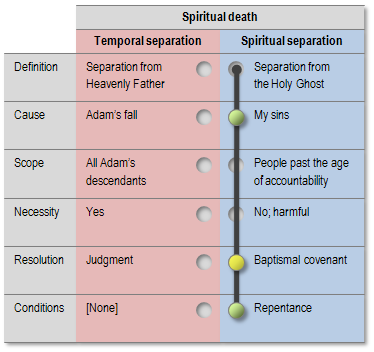
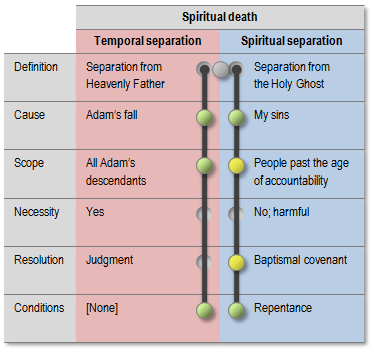

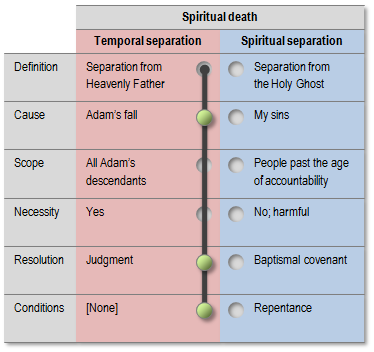
Your #10 evaluated above (Russell M. Nelson, “The Doors of Death,†Ensign, May 1992, p. 72.) is different from the #10 given in the quiz (“Atonement of Jesus Christ,†WhyMormonism.org, accessed 8 Mar. 2011.)
Also, the final sentence from the #3 paragraph (“The Atonement also redeems individuals from the consequences of their own sins on conditions of repentance.”) is missing above but was shown in the quiz reference. Even though Brother Matthews’ article was only about the “Fall of Adam,” and the two resulting deaths, he did manage to covertly squeak in a reference to the other type of spiritual death by pointing out that the Atonement conditionally redeems men from their own sins.
Thanks again for this series
Thanks for those two catches, Matthew. I had planned on including Elder Nelson’s quote in the quiz, but apparently my website’s software couldn’t handle more than 11 polls in the same post, so I had to scrap it. But it snuck back into the “My Answers” post. (Elder Nelson’s tenacious like that. 🙂 )
You’re totally right about Brother Matthews’s last sentence. He was covering his bases quite well, without explicitly labeling that last concept as a type of spiritual death. In resolving the inconsistency between my posts, I decided to omit his last sentence in the quiz post (rather than add it to the answers post) because I think it was throwing some people. Some were rating it Accurate and Thorough, and I think that’s because I didn’t explain my rating criteria well enough. I was only counting those concepts that were explicitly labeled “spiritual death.” So although Brother Matthews accurately describes the cause (“their own sins”) and conditions (“repentance”) of the spiritual separation, I still rated it as simplified because he did not specify that that concept is a type of spiritual death. (I hope that makes sense.)
Rich, thanks again for the reassurance that I’m not speaking to an empty auditorium. 🙂
I hope you leave this series of articles up for as long as the web exists—I want to share them with my kids and grandkids someday. 😉
Thank you SO MUCH for the countless hours you’ve spent carefully studying and sharing your insights.